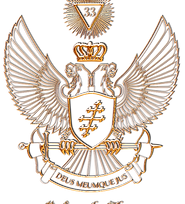ΓΝΩΘΙ ΣΕΑΥΤΟΝ Know thyself, the perilous seat of Ancient and Accepted Scottish Rite?
- 6 Ιαν 2016
- διαβάστηκε 4 λεπτά

Inside The Supreme Council (Mother Council of the World) of the Inspectors General Knights Commander of the House of the Temple of Solomon of the Thirty-third degree of the Ancient and Accepted Scottish Rite of Freemasonry of the Southern Jurisdiction of the United States of America, we find a Throne of marble.
On it, we read the aphorism: "Know thyself."
It 's hard to know thyself. Also, who has the courage to take the seat?
In Arthurian legend, the Siege Perilous (also known as The Perilous Seat) is a vacant seat at the Round Table reserved by Merlin for the knight who would one day be successful in the quest for the Holy Grail.
The Round Table
The Round Table is King Arthur's famed table in the Arthurian legend, around which he and his Knights congregate. As its name suggests, it has no head, implying that everyone who sits there has equal status. The table was first described in 1155 by Wace, who relied on previous depictions of Arthur's fabulous retinue. The symbolism of the Round Table developed over time; by the close of the 12th century it had come to represent the chivalric order associated with Arthur's court, the Knights of the Round Table.
In Thomas Malory's Le Morte D'Arthur, in an account taken from the Vulgate Queste del Saint Graal, the newly knighted Sir Galahad takes the seat in Camelot on Whitsunday, 454 years after the death of Jesus.
The Siege Perilous is so strictly reserved that it is fatal to anyone else who sits in it.
Originally, this motif about the seat and the grail belonged to Perceval, but the Lancelot-Grail Cycle transferred it to the new Cistercian-based hero Galahad.
It appears, for example, in the earlier de Boron Didot Perceval, where Perceval occupies the seat at Arthur's court at Carduel

Cistercian inspiration
The original conception of Sir Galahad, whose adult exploits are first recounted in the fourth book of the thirteenth-century Old French Arthurian epic the Vulgate Cycle, may derive from the Cistercian Order.
According to many interpreters, the philosophical inspiration of the celibate, otherworldly character of the monastic knight Galahad came from this monastic order set up by St. Bernard of Clairvaux.
The Cistercian-Bernardine concept of Catholic warrior-asceticism that so distinguishes the character of Sir Galahad also informs St. Bernard's projection of ideal chivalry in his work on the Knights Templar, De Laude Novae militiae.
Significantly, in the narratives, Galahad is associated with a white shield with a vermilion cross, the very same emblem given to the Templars by Pope Eugene III.
God's Knight
Sir Galahad’s success in the high religious endeavor that was the search for the Holy Grail was predicted before his birth, not only by King Pelles but by Merlin.
Merlin had told Uther Pendragon that there was one who would fill the place at the “table of Joseph”, but that he was not yet born. At first this Knight was believed to be Perceval; however it is later discovered to be Galahad.
Galahad's conception is later glossed by Malory: "And so by enchantment [Elaine] won the love of Sir Lancelot, and certainly she loved him again passing well.” Galahad was conceived for the divine purpose of seeking the Holy Grail.[9] But Galahad's conception happened through pure deceit; under a cloak of deception that was very similar, in fact, to that which led to the conception of Arthur and of Merlin himself. Despite this, Galahad is the knight who is chosen to find the Holy Grail. Galahad, in the Lancelot-Grail cycle and in Malory's retelling, is exalted above all the other knights; he is the one worthy enough to have the Holy Grail revealed to him and to be taken into heaven
The Origin of the aphorism
The maxim, or aphorism, "know thyself" has had a variety of meanings attributed to it in literature.
The aphorism has been attributed to at least the following ancient Greek sages:
Bias of Priene
Chilon of Sparta
Cleobulus of Lindus
Heraclitus
Myson of Chenae
Periander
Pittacus of Mytilene
Pythagoras
Socrates
Solon of Athens
Thales of Miletus
Diogenes Laërtius attributes it to Thales (Lives I.40), but also notes that Antisthenes in his Successions of Philosophers attributes it to Phemonoe, a mythical Greek poetess though admitting that it was appropriated by Chilon. In a discussion of moderation and self-awareness, the Roman poet Juvenal quotes the phrase in Greek and states that the precept descended e caelo (from heaven) (Satires 11.27). The 10th-century Byzantine encyclopedia the Suda recognized Chilon and Thales as the sources of the maxim "Know Thyself."
The authenticity of all such attributions has been doubted; according to one pair of modern scholars, "The actual authorship of the three maxims set up on the Delphian temple may be left uncertain. Most likely they were popular proverbs, which tended later to be attributed to particular sages."
By Plato
Plato employs the maxim 'Know Thyself' extensively by having the character of Socrates use it to motivate his dialogues. Plato makes it clear that Socrates is referring to a long-established wisdom. Benjamin Jowett's index to his translation of the Dialogues of Plato lists six dialogues which discuss or explore the saying of Delphi: 'know thyself.' These dialogues (and the Stephanus numbers indexing the pages where these discussions begin) are Charmides (164D), Protagoras (343B), Phaedrus (229E), Philebus (48C), Laws (II.923A), Alcibiades I (124A, 129A, 132C).[20]
By Aeschylus
Aeschylus uses "know thyself" in its original Greek mythology form in Prometheus Bound. In this play, Prometheus rails against being bound to a cliffside by Zeus, and is cautioned by Ocean that Prometheus should "know thyself".[27] In this context, Ocean telling Prometheus that he should know better than to speak ill of the one who decides his fate, and should know his place.

This image is the entrance of Freemasons Hall
in the town of Boston in Lincolnshire, England. Erected in 1823.


Σχόλια